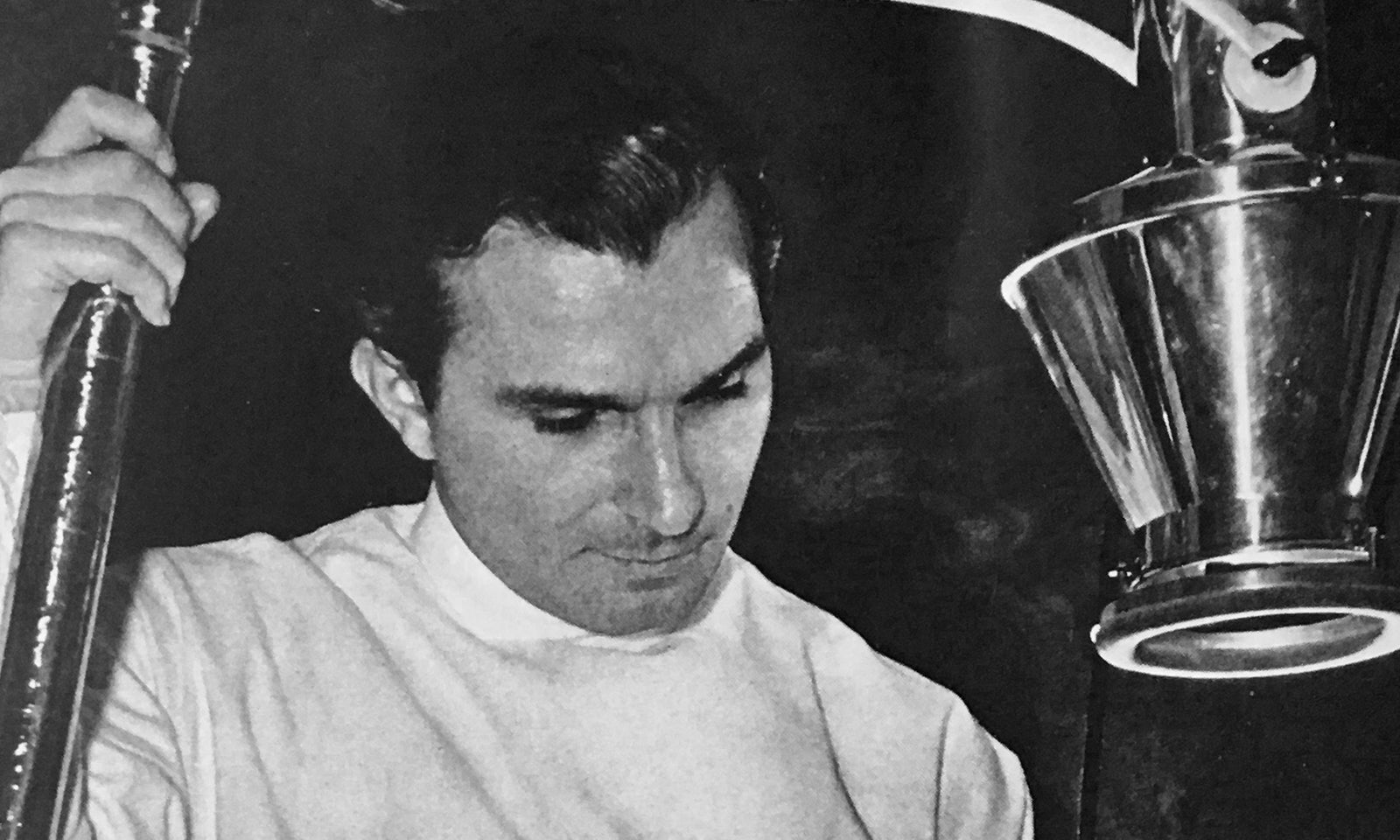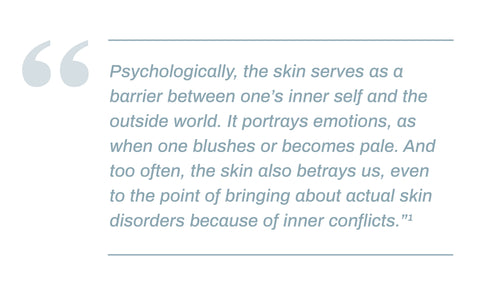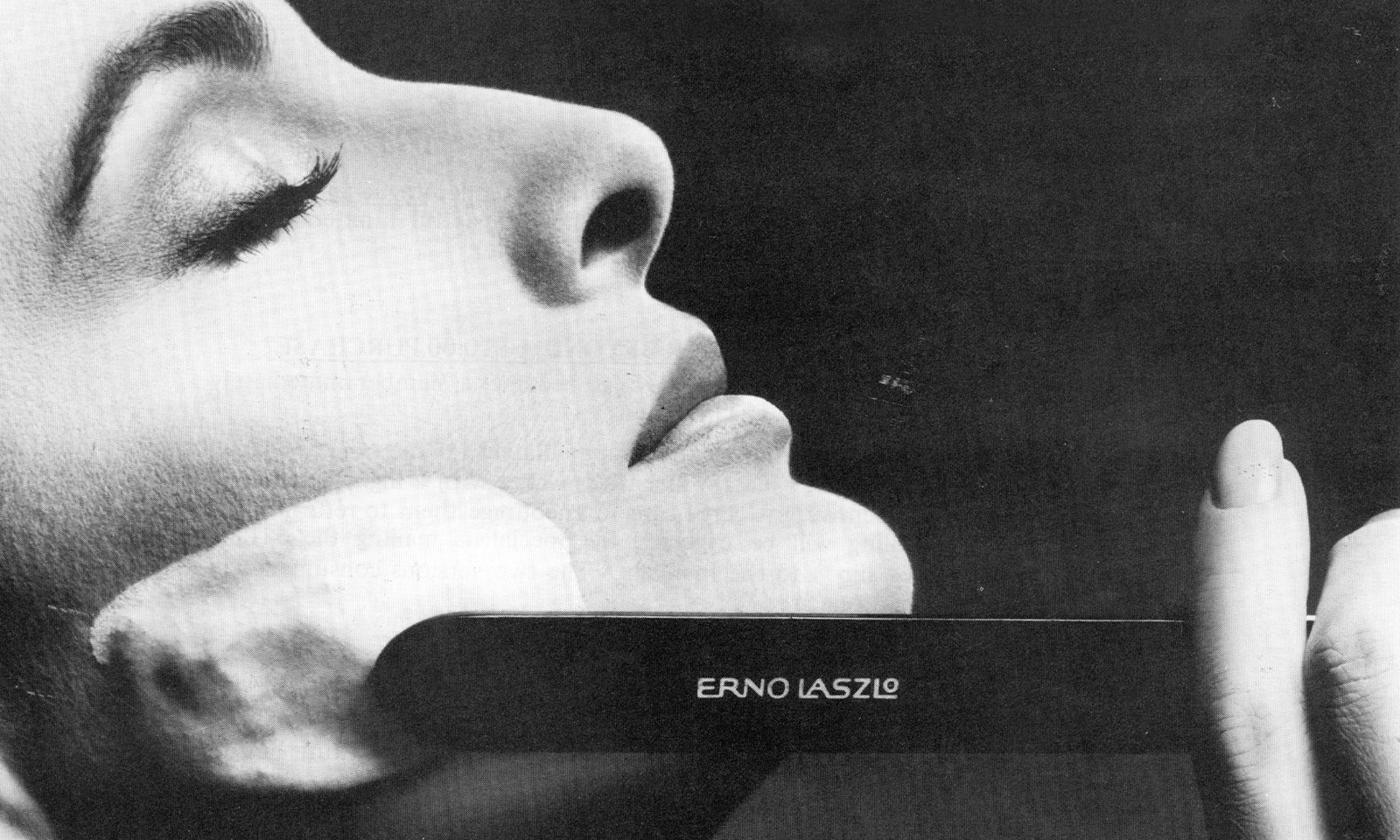
I CAN SEE IT IN YOUR FACE
Insights from Skin Wellness Visionary, Dr. Erno Laszlo
 >
>
This clearly and simply states the mind-body connection between what we feel and how we look, and is a foundational component of psychodermatology, an emerging specialty in dermatology and psychiatry addressing interactions between the skin and mind.2
That statement could have been uttered by any of the physicians affiliated with the Association for Psychoneurocutaneous Medicine of North America (APMNA)3or the late Emiliano Panconesi, one of the founders of the European Society for Dermatology and Psychiatry (ESDaP).4 These organizations, both started in 1993, aim to improve patient care by putting insights gained from research in psychodermatology into practice. But in fact, it wasn’t. This statement was made nearly 50 years before these organizations existed by Dr. Erno Laszlo, a man who dedicated his life and career to helping people let their beauty within shine through their faces, and who knew the complexities of “the essential harmony between a woman’s outlook on her life and her appearance.”5
Psychodermatology, also called psychosomatic dermatology6 or psychocutaneous medicine,7 while long recognizing the link between the skin and the mind, is still considered an emerging field. When you think that back in 400 BC, Greek philosopher Plato lamented that “this is the great error of our day that in the treatment of the human being, the physicians separate the soul from the body,” one could wonder why it’s not the standard of care in 2021. A review of the literature shows that 85% of dermatology patients have indicated that the psychological aspects of their skin disease are a major component of their illness.8
Fortunately, the science of psychodermatology is finally coming into its own—a good thing for patients who struggle with skin conditions and anxiety or other stressors. Yet, the young Dr. Laszlo had many insights into these concerns when he established his practice in 1927 in Hungary. Let’s explore.

The Early Years
His formative years, Dr. Laszlo worked under Max Joseph, a physician noted as the “father of modern dermatology.”9 Joseph observed that when the young Laszlo was away for travel, a good number of patients stopped coming; when he returned, so did they. Laszlo confided that he had embarked on prescribing new formulations based on his own research. Why, asked Joseph, what’s wrong with what we’re prescribing? The answer summed up what would define Dr. Laszlo’s world-renowned approach to skin care: “I observed and listened,” he said.
At the time, dermatological science focused on the treatment of disease, with little focus on what the patient was experiencing. In contrast, Dr. Laszlo listened to his patients first. For example, to get to the cause of why their conditions weren’t improving, he asked patients about their routines and how they were using the prescribed treatments. Patients confessed that they stopped using the foul-smelling ointments once they got home. No wonder their conditions weren’t getting better! With this insight into his patients’ behavior, Laszlo then worked to create his own formulations that were scientifically robust while being more pleasant to use. This was an early insight into the need for ‘listening and learning about what’s not seen while observing what is.’
He listened again when asked by the Royal Court handlers of Princess Stephanie of Belgium to meet with her to address a skin condition, presumably acne, that kept her hidden indoors and away from all social contact—even to the point of jeopardizing her marriage. He listened deeply enough to discern her angst over feeling ‘not good enough’ for her role in society, while he examined her skin. Instead of the heavy purplish glop or white powders that were the treatments of the day, Dr. Laszlo created a preparation that treated the skin while being invisible. He called this “no make-up make-up,” an early version of what is known today as Shake-It Tinted Treatment. The purpose was to treat the underlying problems while allowing Princess Stephanie to feel more confident in her appearance. This was unchartered territory! During that time, women still relied on hiding the skin’s imperfections using methods of covering it up with thick make-up made popular in ancient Egyptian and Chinese cultures. Throughout his career, Dr. Laszlo was outspoken against the overuse of cosmetics to cover skin, often quoted in newspaper articles and speeches where he pleaded for an “educational campaign…[about how] the indiscriminate use of cosmetics on their faces can be worse for their skins than if they used nothing at all.”10 In the 1950s, he told his employees, “The old-fashioned theory of cosmetics as camouflage is out.”11
Much to Princess Stephanie’s good fortune, he persevered and with his tailored preparations and gentle coaching, and over time she built her confidence and took her place in society.
He proved his theory about treating both the skin and mind yet again by developing preparations, based upon his phormula-3 technology, that helped heal scar tissue on the face of famous Hungarian actress, Frida Gombaszögi, when she was shot in the face by a rejected suitor. One can only imagine the intimate conversations between doctor and patient as he worked to restore her physical appearance while building her confidence by treating the unseen scars. After months of consultation and largely to Dr. Laszlo’s credit, Ms. Gombaszögi made a triumphant return the stage!
These early successes spurred on the young doctor to focus more on his research, which led him to open the Erno Laszlo Institute for Scientific Cosmetology, first in Budapest in 1927, then in New York in 1939. His pioneering preparations and mindful rituals that went along with them resonated with European royalty, Hollywood stars and celebrities to whom he became skin advisor and confidante—but that wasn’t what drove him. From his early days throughout his entire career, the mind and body connection, the interconnectedness of how you look and how you feel was his mission, his message.
The Birth of Psychocosmetology
Early on, Dr. Laszlo knew that how a person felt has major implications in how they looked—and it also worked in reverse: how a person looked played a significant role in how they felt. As an undergraduate, he began “wedding medical science to cosmetics”12 to create preparations that would enhance the natural beauty of the skin.
From those early days in the laboratory to the laboratories at his Institutes, Dr. Laszlo continued to formulate preparations for his patients, perfecting and refining them to provide options for clean, healthy skin for his ever-growing clientele. The tradition of Dr. Laszlo’s research continues today as new discoveries in skin care join the tried-and-true treatments that stand the test of time.
Bringing skin care treatments that were revolutionary for the times, Dr. Laszlo took great pride in knowing he was improving the lives of his clients. At this point, he was treating mostly well-off and often famous women, who had the means to afford customized care at his Institute. His deep belief that all women were, or could be, beautiful with his skin wellness treatments and tailored regimens spurred him to explore how to get his preparations into the hands and onto the faces of what he called “the average woman,” whom he praised as highly and with as much respect as he did his celebrity patients.
Skin Wellness for Everyone
In 1952, Laszlo decided to make his preparations available to women and men outside of his Institute by forming partnerships with select upscale department stores. His mission was to help people everywhere feel empowered to be their best selves through a healthy skin complexion. He didn’t want to just sell products; once again, he trained his team of skincare advisers to listen to their clients. Consultants, who were specifically trained in Laszlo’s methods, carefully documented an individual’s skin conditions, then recommended the exact preparations and rituals they needed for their skin types. Each client became a member of the Erno Laszlo Institute following completion of a detailed questionnaire for an “invisible consultation.” This gave them the opportunity to get Laszlo’s expertise all over the USA without the time and expense of a trip to his Fifth Avenue Institute in New York and eventually expanded Dr. Laszlo’s reach to thousands all around the world.
Completing the questionnaire was to be done at home by the client. Each questionnaire, whether for men, women or adolescents, had a unique code to protect the person’s privacy while allowing the Institute to track their product use and make the right recommendations and modifications to each ritual. In keeping with Dr. Laszlo’s holistic approach, in addition to an exhaustive list of questions about skin conditions, skin care routines and make-up use, probing questions were asked about stress levels, relationships, sleeping and eating habits, moods, medications and much more. His pioneering and unique deep enquiry is akin to the modern approach taken today by most psychodermatologists.
The questionnaires were reviewed by Dr. Laszlo himself to be sure he agreed with the consultants’ observations and tailored regimes. He also reviewed periodic progress reports the consultant would complete about client’s skin and their compliance with the prescribed rituals.
This strict approach to treating the skin and the rigorous process and to become an Erno Laszlo skincare consultant was confirmed by Ms. Anne McFadden, the company’s longest-serving employee. “You had to work at Saks for a full year before you could get into the highly coveted Erno Laszlo Institute training program. After that, it took another six months of education and practice before you could start consulting with clients and prescribing the line,” she recalls. Ms. McFadden, who is in her 80s and without a wrinkle on her face, is still going strong as an ambassador for the brand after more than 40 years with the company. “I have clients who have been with me all that time, from all over the world,” Anne says. When asked for the secret to her longevity, she replies simply with, “I believe in the Erno Laszlo preparations and scientific methods.”
In a meeting with his new skincare consultants, Dr. Laszlo engaged them with these words: “I turn to you with confidence in our shared mission: bringing beauty and happiness to thousands of people through the science of cosmetology. Yes, I said science, for it has always been my greatest belief, a belief which I put into practice, that chemistry, medicine and psychology—all must be brought into play in the study and development of cosmetics.”13
Science of Skin and Mind
Dr. Laszlo had an unwavering focus on the science behind the formulations and a deep insight into human behavior. The rooms of his Institutes were calming in décor and decorum. Consultations were private, personal and fully documented. He listened to his patients and his abiding respect for his clientele, mostly women, was evident in the way he talked to them and about them. He understood them when hemarveled, “Beauty is both physical and psychological. A beautiful skin, for example, can be a woman’s greatest psychological asset. An unsightly one can reflect misery mentally and handicap a woman’s whole personality.”14
Taken all together—the interconnectedness of dermatologic science plus the preparations and rituals to beautify the skin plus the emotional wellbeing component—it can be confidently stated that Dr. Erno Laszlo is the father of ‘psycho-cosmetology,’ a phrase he coined early in his career. His insights and ongoing research paved the way for today’s focus on the benefits to patients that can be expected when the mind and skin are understood and treated holistically through the modern practice of psychodermatology.
The Laszlo Method
His approach was revolutionary for its time and stands the test of time, as well. Let’s see how.
Of his science-based preparations, Dr. Laszlo said, “Ours is honest magic without trickery.”15
Let’s start with the basics: cleanliness. The facial cleansing method of choice in the 1940s and ‘50s was to use cold cream to remove makeup and moisturize the skin. Dr. Laszlo was aghast that women were leaving dirt and oils on their faces. In an article in the April 3, 1952, Atlanta Journal, he told columnist Lois Norvell, “Water is a daily necessity for every skin. People take baths every day, wash their hands 20 times a day. How is it possible that they say, ‘from the chin down, water; from the chin up, no water’? Water can give you a lift to skin beauty quicker than any cosmetic. If water did not exist, as a cosmetologist, I would have to invent it.”16 Maintaining clean and well hydrated skin is a cornerstone of the Erno Laszlo healthy skin ritual and promoted by all dermatologists today.
Next, Dr. Laszlo was a pioneer in the early science and understanding of the acid mantle17 on the skin (dubbed the “acid cloak” by Dr. Laszlo). The acid mantle is a thin film on the surface of the skin that acts as a barricade against bacteria and keeps moisture in. Its slightly acidic pH makes it the skin’s first line of defense against the elements.18 Essential fatty acids are components of a healthy acid cloak. Dr. Laszlo explained in a discussion at his NY Institute in September 1952: “Without these fatty acids, our skin would be a breeding ground for millions of bacteria. The appearance of aging skin is caused by fatty acid deficiency and an excess alkaline condition.” He called the discovery of the skin’s acid cloak formed by fatty acids one of the greatest advances in modern dermatology. He theorized that most complexion issues that were not from systemic causes could be avoided with a healthy essential fatty acid protective cloak.
Working tirelessly on formulations using fatty acids, he developed a “unique substance entirely new to the science of cosmetics with a pH almost identical to the normal pH of skin.”19 He called it pHelityl.
Read how Philadelphia Inquirer reporter Cynthia Cabot described it in her April 2, 1952, article: “Revolution is a mild term for the beliefs and theories on which Dr. Laszlo has established his treatments. He has polished up a contradictory term called “fatty acids” to describe the X-quotient every skin should have to stay beautiful. The number 17,776 might sound like a telephone figure to you, but actually, it is the lucky number for thousands of women who have ‘discovered’ the discoveries of Dr. Laszlo. After experimenting for years with formulas and ideas, he finally settled on the results held by test tube number 17,776, the ‘fatty acid’ complex he has called pHelityl.”
Medical Skin Wellness
Dr. Laszlo often noted his mentor Joseph’s view that “only a doctor trained and experienced in all branches of medical science can be a good dermatologist.”20 Through his training as a dermatologist, his keen interest in people and his attentive listening, Laszlo brought the best of medical science to the practice of cosmetic dermatology. Because patients would use his preparations over the unappetizing concoctions from an older era, Dr. Laszlo noted that “this is where [cosmetic dermatology] comes to the rescue of dermatology.”21
He was interested in the health of the entire body, so his prescribed routines and regimens were not confined to skin care. Dr. Laszlo recommended healthy eating over, drinking plenty of water, exercising, avoiding sun overexposure, and paying attention to mental wellbeing.
Reviews of current skin care literature bear out the theories Dr. Laszlo pioneered or championed: pH balance, essential fatty acids and a healthy acid mantle are still the route to a healthy, vibrant complexion. From an overall health viewpoint, current medical and mental health advice from physicians and psychologists concur with Dr. Laszlo’s recommendations from the last century. His cutting-edge insights and methods in his time are still relevant in ours.
Self-care: What’s Love Got To Do With It?
While physicians are acknowledging the holistic care of skin and the mind in the practice of psychodermatology, the public has swiftly embraced the concept of self-care. Self-care is defined as taking steps to look after your physical and emotional health. The goal is wellness, coping with daily stressors and being the best one can be. Certainly, accelerated by the global pandemic, interest in self-care is on the rise. Google Trends reports web searches for the term have more than doubled since 2015.22 It’s not about being indulgent or selfish; it’s about loving yourself enough to be aware of how you feel and to focus on your wellbeing so you can do your daily tasks, including caring for others.
Throughout his career, Dr. Laszlo counseled his patients in the art and importance of self-care, way before it became a “thing.” He expected his patients to rigorously follow his instructions, which included at least twice daily care of the skin in a specialized ritual of cleansing, splashing, moisturizing. He was known for dropping patients who didn’t take his counsel seriously. In what now seems like enforced self-care, Laszlo knew that a healthy, daily skin care routine had benefits well beyond a clean face. It provided his patients, mostly women, with time to themselves, a moment to pause, to think and regroup.
Modern dermatologists note that any act of skin care can be considered self-care, which can be an important step to improving mental health. “By having a set routine, one knows what to expect, and this is a relief,” dermatologist Marie Jihn said. “The more a routine it becomes, the less stress it becomes. In the process, you also look better.”22
Read what NY Mirror columnist Alma Archer said about Dr. Laszlo’s approach over 80 years ago in a June 11, 1940, article: “The first tenet of the Laszlo credo of beauty is that it comes from within. Although the face and scalp treatments include the application of creams… and individual preparations for home care, immense stress is laid on the inner condition of the woman’s body. Even her psychology is explored to discover whether her beauty troubles are chronic or the temporary result of emotional or mental strain.”23 Talk about self-care!
Beauty in One’s Own Mind
Dr. Laszlo was prolific in attestations about his view of women. Recounting with pride that he worked with and for women his entire career, he often noted his admiration because “women have achieved a miracle in the face of overwhelming odds – men!”2
While he is famous for being the skin care counselor for the likes of Greta Garbo, Audrey Hepburn, Marilyn Monroe and Jacqueline Kennedy Onassis, he was enamored of all women and assured them they could get the same results as these famous ladies by strictly following his skin care instructions.
He maintained that beauty was ageless and shone from within stating that “A young girl can be pretty. It takes maturity to attain beauty. It is a question of nuance.”25
When accepting an award for his work, he likened his preparations to inventions of Edison, Bell, and the Wright Brothers, noting, “It is not my own importance that I wish to stress, but the importance of a woman’s face. A face represents not only beauty but all the qualities of the heart, soul and brain.”26
Dr. Laszlo spent his entire career changing the perceptions of his clients, moving them away from unconscious acts of self-absorption to a nuanced and deliberate process of self-actualization.
Laszlo recognized that women should pursue beauty for themselves, a rather revolutionary perspective when he provided this viewpoint during an interview on January 31, 1940, with columnist Charles Estcourt, Jr.: “When a woman wants to be beautiful for her own sake, then she is happy. When she wants to be beautiful for the sake of someone else, she is not happy and is heading for greater unhappiness.”27
Actress and humanitarian Audrey Hepburn famously said, “I owe 50% of my beauty to my mother and the other 50% to Erno Laszlo.” This icon of beauty, poise and grace also said, “I believe that happy girls are the prettiest girls.”
Erno Laszlo concurred when he said in 1951, “The most miraculous of all beautifiers is happiness.”28
References
- Institute Package_SKM_C30821070212490
- Concepts in Psychodermatology: An Overview for Primary Care Providers, 2020, https://doi.org/10.1016/j. 2020.04.015
- Association for Psychoneurocutaneous Medicine of North America (APMNA); http://www.psychodermatology. us/page-1823653
- European Society for Dermatology and Psychiatry (ESDaP); https://www.psychodermatology.net/page1. aspx?p=13&t=1
- New York City Mirror, June 11, Laszlo Archive IIA46m.tif
- https://www.medicaljournals.se/acta/content_files/files/pdf/96/217/EditorialSuppl217.pdf
- https://oxfordmedicine.com/view/10.1093/med/9780199568741.001.0001/med-9780199568741-chapter-262
- Marshall C., Taylor R., Bewley A. Psychodermatology in clinical practice: main principles. Acta Derm Venereol 2016; Suppl 217: 30-34.
- Jewell , The Angel of Beauty. 1998. Erno Laszlo LLC, p.14.
- 1951 Speech to Fashion Laszlo Archives, p.3
- Employee Laszlo Archives
- The Story of Erno Laszlo. Laszlo Archives
- Employee Laszlo Archives, p.2
- 1951 Speech to Fashion Laszlo Archives, p.2
- Honesty without trickery
- Atlanta Journal, Date
- Surber C., et al. The acid mantle: a myth or an essential part of skin health. Curr Probl Dermatol . 2018;54:1-10. Epub 2018 Aug ; DOI: 10.1159/000489512
- Understanding your skin’s acid mantle and why it’s so Good Housekeeping Institute. Oct. 15, 2020. https://www.goodhousekeeping.com/beauty/anti-aging/a32497176/what-is-acid-mantle/
- Address from Laszlo at the Erno Laszlo Institute, NY, Sept. 9, 1952
- Laszlo manuscript 1965, p. 23
- Lawler M, Laube What Is Self-Care and Why Is It So Important for Your Health? https://www.everydayhealth. com/self-care/
- Rearick When Skin Care Is Also Self-Care. HuffPost, Feb. 26, 2018. https://www.huffpost.com/entry/skin- care-is-self-care_n_5a86e975e4b00bc49f4341dc
- NY Mirror columnist Alma Archer said about Laszlo’s approach 81 years ago in a June 11, 1940
- 1951 Speech to Fashion Laszlo Archives
- Philadelphia Inquirer reporter Cynthia Cabot described it in her April 2, 1952
- Award Speech, Laszlo Archives
- January 31, 1940 interview with columnist Charles Estcourt, Jr
- 1951 Speech to Fashion Group. Laszlo Archives




Leave a comment
This site is protected by hCaptcha and the hCaptcha Privacy Policy and Terms of Service apply.